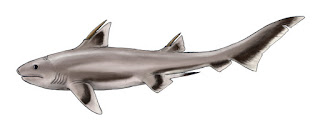Ancient Seas #4
Hybodus
 |
| Photo from New Dinosaurs |
Kingdom: Animalia
Class: Choridricthyes
Conservation Status: Extinct (EX)
Found: Worldwide
Era: Permian - Cretaceous
Lived: 303.4 million - 66 million years ago
Diet: Everything.
Weight: 90.7kg (200lbs)
Size: 2m (6.6ft)
Habitat: Shallow seas
The Hybodus is an ancient shark species which lived up until 66 million years ago. Unlike most sharks, these species were around for well over 200 million years. This is over ten times the average span of shark species as they are usually around between 10-20 million years. This was a successful shark, living through the Triassic, Jurassic and Cretaceous eras. Considering that it shared waters with plesiosaurs and mosasaurus who were both big predators; this is very impressive. It is not really known why they even went extinct.
In appearance, Hybodus are your classic shark. They have the seven fins, the streamline body, the cartilage skeleton... the list goes on. They are compared to great whites, but are much smaller in stature. They grew up to 2m (6.6ft), which is not much bigger than the size of an average man. Their mouths were not very large, limiting the size of prey they could consume. So rather than hunting like a typical shark, Hybodus were an opportunistic predator. This meant they ate whatever they could get; whatever it was, from fish to marine creatures to everything between.
Hybodus did have some features which make it stand out from other sharks, however. On its dorsal fin was a bony blade which is theorised they used in defense. The males also had claspers, an organ vital in reproduction. The males used these to grip the females and use a more direct method of fertilisation. While this was different to their peers at the time, it is a feature used in modern sharks today.
Their main defining feature was having two sets of teeth. From what I can surmise, the first set of teeth were sharp and they jutted from their jaw. These teeth would have been for catching prey like fish and whales, as well as a defense mechanism against some of the other big predators of the day. The second set were wide and flat, ideal for crushing shelled creatures like molloucs. It was these teeth which allowed for such a varied diet and is probably a massive contributor to their longevity and success.
The Hybodus was a wide spread speices, covering most of the world. We know this because of their fossil distribution. This could partly be down to the fact they had partially calcified cartilage, making it stronger than other shark skeletons. It helped give them a edge with their survival - giving them the opportunity to spread throughout the world. Their apparent abundance is why there are so many fossils today.
 |
| Photo from Dinopedia |
Fun facts!
- Hybodus means "humped tooth".
- The first Hybodus teeth were found in 1845, in the UK.
- They had accute hearing.
- Some accounts claim they also possessed little horns, but I'm not entirely sure about that!



Comments
Post a Comment